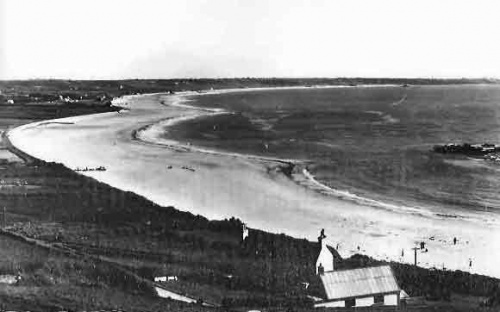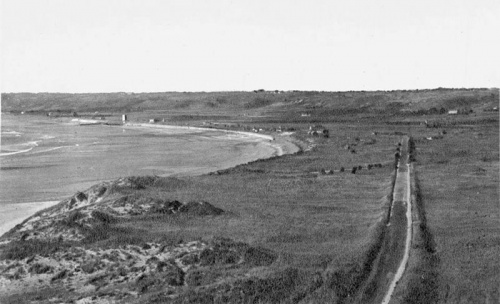Grande Route des Mielles
Mikebisson (Talk | contribs) m (picture added) |
(Pegman added) |
||
| (3 intermediate revisions by 2 users not shown) | |||
| Line 1: | Line 1: | ||
| − | {{Box|icon=[[File:JerseyHeritagelogo.png|center|100px]]|header=What's your street's story? - Five Mile Road|picture=[[File:FiveMileRoad1.jpg| | + | {{Box|icon=[[File:JerseyHeritagelogo.png|center|100px]]|header=What's your street's story? - Five Mile Road|picture=[[File:FiveMileRoad1.jpg|350px|center]]Grande Route des Mielles from La Pulente looking north|intro=This article is based on a presentation in the Jersey Heritage What’s your street’s story? series <br/> <br/> [[File:StreetViewPegman.png|center|50px|link=https://www.google.com/maps/@49.1951928,-2.2247959,3a,60y,90t/data=!3m6!1e1!3m4!1sGllgNOjxjOV4pLbTkYgmww!2e0!7i13312!8i6656]]Click on Pegman <br/> to view the location in Google Street View <br/> <br/> }} |
| − | [[File: | + | |
Grande Route des Mielles, which runs along Jersey's west coast from Les Laveurs to the St Peter/St Brelade boundary, where it becomes Route de la Pulente, is popularly known to islanders as the Five Mile Road, although it is only just over three miles long. | Grande Route des Mielles, which runs along Jersey's west coast from Les Laveurs to the St Peter/St Brelade boundary, where it becomes Route de la Pulente, is popularly known to islanders as the Five Mile Road, although it is only just over three miles long. | ||
| Line 43: | Line 42: | ||
The story of the Five Mile Road or Grande Route des Mielles therefore provides an interesting view of both social and military history, as well as the beautiful natural landscape epitomised by places such as St Ouen’s Pond and Mielle de Morville. | The story of the Five Mile Road or Grande Route des Mielles therefore provides an interesting view of both social and military history, as well as the beautiful natural landscape epitomised by places such as St Ouen’s Pond and Mielle de Morville. | ||
| + | |||
| + | *[[St Ouen's Bay]] | ||
Latest revision as of 13:11, 15 April 2023
Grande Route des Mielles, which runs along Jersey's west coast from Les Laveurs to the St Peter/St Brelade boundary, where it becomes Route de la Pulente, is popularly known to islanders as the Five Mile Road, although it is only just over three miles long.
It is the island's longest stretch of open road and the La Pulente end is used for car club time trials and other events. Before the introduction of an all-island speed limit (and on regular occasions since) the road has been used by drivers anxious to put their foot down on the accelerator and remind themselves how their vehicles are capable of performing.
History
The Five Mile Road, or Grande Route des Mielles as it is officially known in the almanac, has been synonymous with the wide variety of history, natural landscape and the great surf that St Ouen’s Bay has to offer.
But what are its origins? Close examination of the Godfray map of 1849 shows that while roads existed at both ends of St Ouen’s Bay, there was no road between Les Laveurs and La Pulente . However, investigation of the States of Jersey minutes reveals that they gave approval for a military road on 21 September 1855, following a report by the Island’s Defence Committee, with an initial grant of £300.
By 1867 the map of Jersey by Staff Commander J Richards clearly shows a road running the length of the bay, while the individual committee books indicate through the minutes of the committee responsible for Grande Route des Mielles that work on the road continued throughout the 1860s and into the early 1870s. In fact a report by the committee on the 14th October 1869 requested the States of Jersey for a grant of further sums of £300 for both 1870 and 1871, in order to complete more work on the road including Mont de la Pulente. This suggests that even after it was built and had provided a link between L’Etacq and La Pulente various amendments continued.
Either way St Ouen’s Bay from this point on was transformed and what had been largely rural and sparsely populated, with the beach the only way of travelling from one end to the other, now become a more widely used and accessible area as a result of the Five Mile Road. With the arrival of the 20th century the natural beauty of the large expanse of sand dunes (or mielles), beach, and good surf became an obvious draw for both islanders and tourists.
The road covers the large stretch of sand dunes from La Route de la Pulente ending near to Lewis Tower and Les Laveurs. Historian Frank Falle has suggested that the name, given that the road is actually not 5 miles in length, originates from the distance from La Corbiere to L’Etacq of about 5½ miles.
The road spans the three parishes of St Ouen, St Peter and St Brelade.
Some mention should be made of those buildings and events prior to the road’s existence. Across the centuries St Ouen’s Bay proved a focal point of foreign invasion, resulting in numerous defensive fortifications being constructed during the 18th and 19th centuries, as well as by the Germans during the Occupation. This was highlighted during the conflicts of the English Civil War, when with the defeat of Charles I, the leader of the Parliamentarians, Oliver Cromwell, focused on other Royalist strongholds such as Jersey.
Consequently, on 20 October 1651 Admiral Blake arrived with a parliamentarian army in St Ouen’s Bay, and while bad weather delayed a landing, two days later Colonel James Hearne and the Roundhead force had landed on St Ouen’s beach. The Royalist Governor George Carteret retreated to Elizabeth Castle, but subsequently surrendered and the Island fell under Cromwell’s rule for nine years.
French invasion
This was followed by the failed French invasion attempt by Prince Nassau at St Ouen’s Bay on 1 May 1779, convincing the Island of the need for more defensive fortifications along the bay, which included gun batteries, redoubts and entrenchments. This continued with a number of towers built in the 19th century, such as Kempt Tower in 1834 and Lewis Tower completed in 1835. In Lewis Tower’s case this wasn’t without complication after Seigneur Philip du Heaume raised a Clameur de Haro over the common land rights of himself and local farmers, which had to be settled before the local workforce would return to work.
Following the building of the Five Mile Road and a continuous route across the bay, military influence continued to play a role with events such as the First World War. The need for prisoner of war camps resulted in the building of the timber camp at Blanches Banques, where the first German POWs arrived for internship on 20 March 1915. The commandant of the camp was Lt-Col G Haines and a number of interesting documents exist about the camp, including greeting cards, letters on the arrival of prisoners of war and a letter from the army contractor Edward Lander, of 3 Brook Street, concerning the supply of cigars.
The next major military impact on the area came with the German Occupation of the Island in World War II, when the Island as a whole was heavily fortified. The large-scale building of fortifications along the Five Mile Road led to many bungalows and existing properties at this time being destroyed. This is clearly highlighted in a letter from the President of the States Department of Labour on 22 July 1941 to the Bailiff of Jersey, Alexander Coutanche, where he mentions the daily destruction.
However the military story is only one aspect in the history of the road and its surrounding area, equally the road and St Ouen’s Bay in general have since the 20th century been a draw for both local and international surfers and surfing is an integral part of the social history here. The early stages of surfing in Jersey were very much launched with the formation of the Island Surf School of Jersey, by Nigel Oxenden in 1923. Although it no longer exists, it is generally recognised as Europe’s oldest surf club and started the strong connection between surfing, the Watersplash and St Ouen’s Bay.
Buildings such as the Watersplash have become iconic landmarks for the surfing community. Built by Arthur Parker, the property originally called Idaho became known as the Watersplash after the Occupation, and its transformation from a residential home occurred with its purchase by Harry Swanson on 24 January 1948. MrSwanson was to prove very supportive of the promotion of Jersey surfing, bringing the South African lifeguards to the Watersplash area. Besides patrolling the beach, they introduced locals to stand-up surfing. Harry Swanson also opened the venue to the fundraising efforts of Jersey Surfboard Club, which was formed in August 1959 with Peter Lea as president.
The club was very instrumental in establishing Jersey as the surf capital of Europe during this period, with the first UK regional contest in 1963 and the first British Championship in 1964, both held in St Ouen’s Bay. Another key building in the surfing history of the Five Mile Road is El Tico, which became the site for Jersey Life Guard Station and Centre, which was approved in 1965. The cafe itself opened in 1948, after it was built on land purchased by Maurice King in 1946, who took James Holloway and his wife as partners in the property in order to complete it. The two buildings, together with other key spots along the road have proved focal points for surfing over the decades and played a role in both the national and international success of the Island’s surfers.
Holiday accommodation
A further part of the story revolves around the growth of Jersey as a holiday destination, with the building of various hotels, bars, guesthouses and even at one point a holiday camp. This was the Chateau Plaisir, which in the early years of its life was a holiday camp with some 80 chalets, after being bought in 1934. However, with advent of the war it was requisitioned first by the States of Jersey for an Army Boys Technical School, before being destroyed by the Germans in the Occupation and replaced with a water-pumping bunker. It resumed life as tourist accommodation after the war, though its days as a holiday camp were over, following a refusal by the States. Instead a hotel was built. Other tourist accommodation on the Five Mile Road included the Pro-Tem guesthouse, which was later called the Cutty Sark and was built on land acquired by Kenneth Britton in 1932.
The protection of the natural landscape has ensured that only limited residential development has occurred along the road and the Godfray map of 1849 shows only the property of J Carrel existing near Val de la Mare. Many of those existing today are post-1900, including Atlantique cottage, built on land acquired by John Francis Le Cornu on the 19 November 1904 and originally called Five Mile Cottage, which at one point was owned by Jesse Boot.The story of the Five Mile Road or Grande Route des Mielles therefore provides an interesting view of both social and military history, as well as the beautiful natural landscape epitomised by places such as St Ouen’s Pond and Mielle de Morville.





